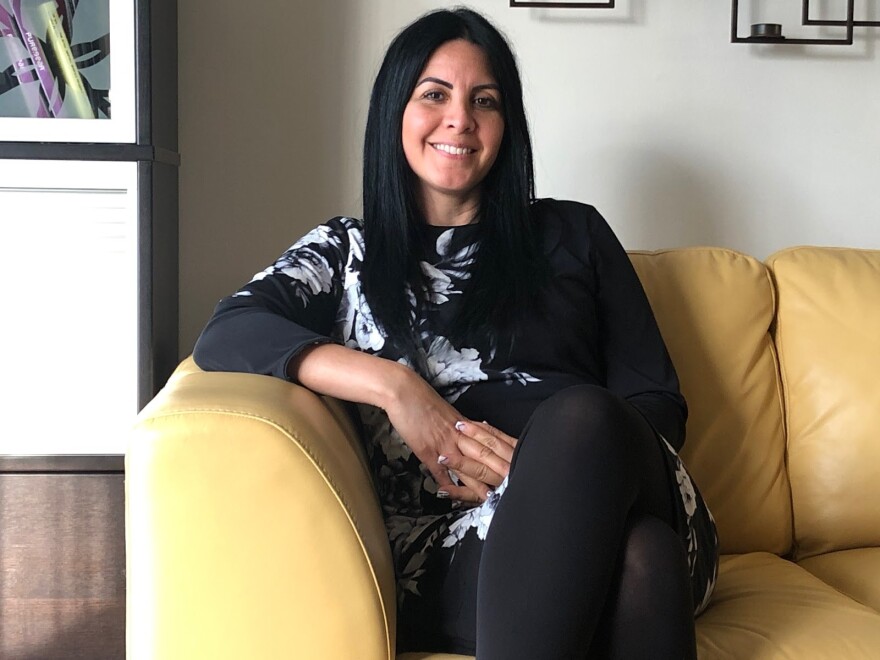The 32 fourth graders in Mirtha Sebelen’s class on Long Island see a lot of red and blue. Sebelen color codes everything she writes on her whiteboard. She uses the red marker for Spanish, blue for English. Studies show this dual language model is what New York schools should use to teach English learners. But most don’t.
Half of Sebelen’s students are “newcomers” from Central and South America, so they speak little, if any, English.
“I’m like a regular classroom teacher,” Sebelen explained. “I teach all the subjects. But my work as a bilingual teacher is double because not only do we have to teach what the regular teachers teach in their classroom, which is in English, we also have to teach the content area in the home language on top of all that.”
Sebelen started teaching bilingual classes 14 years ago in New York City, then Brentwood, and now Nassau County. She says students learn more when she speaks in both English and their home language.
“When you start talking to them about their countries, or whatever they like to eat, that’s their background knowledge,” Sebelen said. “Whatever they already know from their life, that helps them show a lot of progress.”
Few classrooms on Long Island run like Sebelen’s. That’s due to a shortage of certified bilingual teachers. At the same time, a recent report shows multilanguage learners in New York schools have grown 20 percent over the past decade – and many of them live on Long Island.

Priscilla Zarate worked on that report. She says because of the teacher shortage, most school districts on Long Island have English-only programs for immigrant students.
“What happens is that you have a student now that is coming in for the first time from another country, coming into the school system, and first we’re not providing home language support, because everything they’re being thrown into is in English, a language that they really do not understand,” Zarate said.

Zarate, a Suffolk County Hispanic Advisory Board member, says the report shows New York schools fail English learners. Between 25 and 30% of those students on Long Island drop out. That’s partly because they need to pass the same English Regents test that native speakers do in order to graduate.
“They feel like they don’t have the support, they are not able to communicate with the teachers, and they feel, ‘well the system is failing me so I have no need to be here,’” Zarate explains. “So they prefer to go and take care of the immediate need and work.”
Sometimes those students go on to pay tuition to learn English. Suffolk County Community College offers English as a Second Language courses that fill the gaps left by public schools. Laura Cudia is a program coordinator at the college.
“The other day a student came in, she left high school because it was just frustrating for her and now she’s taking non-credit classes because she just wants to learn English,” Cudia said. “So sometimes high school is very frustrating for them, if they get here at 10th or 11th grade, they give them a few extra years to take the Regents, to graduate. However, do you want to be in high school at 21-years-old? No.”
Cudia says she cannot admit students younger than 18. That leaves those kids in high schools with bilingual teacher shortages. Nancy Villarreal de Adler, executive director of The New York State Association for Bilingual Education, says things get more complicated as more Mandarin and Bengali speakers move to Long Island.
“For example, if you have an influx of Chinese students you may have a certified teacher, bilingual, but in Spanish language,” Villarreal de Adler said. “What use is that?”

She says districts need funding in order to attract bilingual teachers. Support from local and state politicians is needed to accomplish this.
“What we are trying to do statewide is to identify resources within the communities, prospective teachers, prospective individuals who may be willing to go into the teaching profession,” Villarreal de Adler said.
Teacher Mirtha Sebelen was a multi-language learner herself. She says a bilingual teacher inspired her to join the profession – her mother. Now she’s a role model for her own students. Sebelen already sees a change in the 4th graders she’s taught for two years.
“I have a few students, who last year didn’t speak a word in English, and they’re already having conversations in English, writing paragraphs or stories, so I do see the progress,” Sebelen said.
Dual language classrooms like Seleben’s depend on multilingual teachers…and Seleben hopes to inspire more people to get certified.


